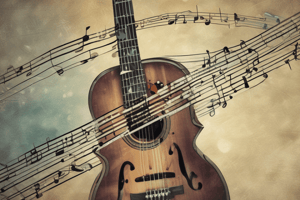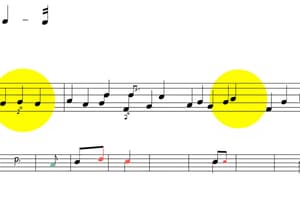Podcast
Questions and Answers
What best describes vertical intervals in music?
What best describes vertical intervals in music?
- The pitch distances between two notes played simultaneously. (correct)
- The time intervals between two notes in a melody.
- The distances between two notes played sequentially.
- The volume difference between two notes.
How can a 7th chord be inverted?
How can a 7th chord be inverted?
- By removing the root note.
- By changing the quality of the chord.
- By adding an additional note.
- By moving the lowest note up an octave. (correct)
Which of the following represents chord construction with two major thirds?
Which of the following represents chord construction with two major thirds?
- Diminished chord
- Major chord
- Minor chord
- Augmented chord (correct)
What is the purpose of pivot chords in music?
What is the purpose of pivot chords in music?
What is defined as passing notes in musical context?
What is defined as passing notes in musical context?
What must be avoided when doubling notes in harmony?
What must be avoided when doubling notes in harmony?
Which type of motion occurs when two notes move in opposite directions?
Which type of motion occurs when two notes move in opposite directions?
What defines the quality of a chord and cannot be omitted?
What defines the quality of a chord and cannot be omitted?
What is the purpose of a pivot chord?
What is the purpose of a pivot chord?
Which of the following describes a secondary dominant?
Which of the following describes a secondary dominant?
What happens to the seventh of a note in harmonic progression?
What happens to the seventh of a note in harmonic progression?
What type of chords includes extensions such as 7th, 9th, and 13th?
What type of chords includes extensions such as 7th, 9th, and 13th?
What do appoggiaturas typically do in a melody?
What do appoggiaturas typically do in a melody?
Flashcards
Pedal Note
Pedal Note
A note that sustains while other notes change above it, commonly used in classical music to create a sense of depth and harmonic movement.
Secondary Dominant
Secondary Dominant
A dominant chord that functions as the dominant of the dominant, creating a strong pull to the target key in a modulation.
Pivot Chord
Pivot Chord
The dominant chord of the key that is one fifth above the original key, used to smoothly change the key during a modulation.
Parallel Motion
Parallel Motion
Signup and view all the flashcards
Contrary Motion
Contrary Motion
Signup and view all the flashcards
Passing Notes
Passing Notes
Signup and view all the flashcards
Neighbor Note
Neighbor Note
Signup and view all the flashcards
Appoggiatura
Appoggiatura
Signup and view all the flashcards
Vertical Interval
Vertical Interval
Signup and view all the flashcards
7th Chord
7th Chord
Signup and view all the flashcards
Chord Movement
Chord Movement
Signup and view all the flashcards
Study Notes
Theory Notes
- Two minor thirds are diminished, two major thirds are augmented. A minor third and a major third are either major or minor.
- Avoid doubling the leading note at the start of a bar. Don't double a major third with a minor third (octaves are acceptable). You must not omit the third as it determines chord quality.
- Pedal notes are lower notes that remain while upper notes change. Types of motion include contrary (opposite directions), similar (same direction, same interval), and oblique (one note stationary).
- Parallel motion occurs when notes move in the same direction with the same interval. Parallel thirds and sixths are acceptable.
- The seventh of a note resolves down by step (to the note below). The leading note resolves to the tonic.
- Augmented sixths involve building an octave, then lowering the higher octave by a semitone.
- Major thirds on augmented sixths create Italian sixths.
- Major triad on augmented sixths form German sixths.
- Minor thirds on augmented sixths create French sixths.
Chord Theory
- Pivot chords are used for smooth key changes during modulation. These chords relate to both the original and new key. (e.g., (Q2/5)).
- Diatonic notes are within a scale, chromatic notes are outside.
- Major keys can be established by moving 1 semitone down from the last sharp and using primary chords.
- Secondary dominants and other chord extensions (7ths, 9ths, 11ths, 13ths) strengthen progressions.
- Melodic decoration uses non-chord tones (e.g., passing, anticipation, appoggiatura).
Chord Inversions and Intervals
- 7th chords, like triads, can be inverted by moving the lowest note.
- Vertical intervals are the distances between concurrent notes (measuring size like 2nds, 3rds etc, in combination with quality such as major, minor) and are used to create harmony.
Studying That Suits You
Use AI to generate personalized quizzes and flashcards to suit your learning preferences.




